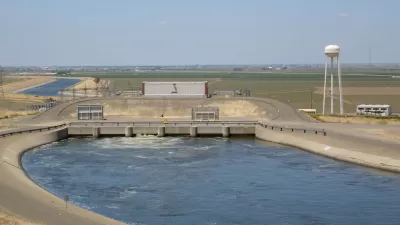As California faces its third dry year in a row, following the driest year in the state's recorded history, communities are facing the prospect of water rationing. However, some of the state's largest cities have been spared for the time being.
Though the images of barren mountain ranges normally covered in snow are startling, "from a hydrological and water supply perspective, the state is just now tipping into drought," observes Bettina Boxall. "Gov. Jerry Brown has not yet issued an official drought proclamation but said Monday that he soon will. 'It's really serious,' Brown said, noting that 2014 could be California's third dry year in a row. 'In many ways it's a mega-drought.'"
The seriousness of the situation, however, is spread unevenly across the state. Southern California and San Francisco should be able to ride out the drought without resorting to rationing for quite some time. "The story will be different for ranchers, communities that depend on local surface supplies and many San Joaquin Valley growers, particularly on the valley's south and west sides," notes Boxall. Sacramento approved mandatory rationing this week.
For an explanation of the unusual scientific phenomenon that's keeping the rain away (one researcher dubbed it the "Ridiculously Resilient Ridge"), see this article in the San Jose Mercury News. And for tips on how to reduce water demand and augment supply, Laura Tam has assembled a terrific list of tools for SPUR.
UPDATE (1/17/14): Governor Jerry Brown officially declared a drought emergency for the state this morning, report Josh Richman and Paul Rogers in the San Jose Mercury News. "The governor asked California residents and businesses to voluntarily reduce their water consumption by 20 percent. In practical terms, the drought declaration also streamlines the rules for water agencies to transfer extra water from one part of the state to another, easing shortages. It also raises public awareness."
FULL STORY: California areas brace for water rationing as reservoir levels fall

Alabama: Trump Terminates Settlements for Black Communities Harmed By Raw Sewage
Trump deemed the landmark civil rights agreement “illegal DEI and environmental justice policy.”

Study: Maui’s Plan to Convert Vacation Rentals to Long-Term Housing Could Cause Nearly $1 Billion Economic Loss
The plan would reduce visitor accommodation by 25% resulting in 1,900 jobs lost.

Why Should We Subsidize Public Transportation?
Many public transit agencies face financial stress due to rising costs, declining fare revenue, and declining subsidies. Transit advocates must provide a strong business case for increasing public transit funding.

Paris Bike Boom Leads to Steep Drop in Air Pollution
The French city’s air quality has improved dramatically in the past 20 years, coinciding with a growth in cycling.

Why Housing Costs More to Build in California Than in Texas
Hard costs like labor and materials combined with ‘soft’ costs such as permitting make building in the San Francisco Bay Area almost three times as costly as in Texas cities.

San Diego County Sees a Rise in Urban Coyotes
San Diego County experiences a rise in urban coyotes, as sightings become prevalent throughout its urban neighbourhoods and surrounding areas.
Urban Design for Planners 1: Software Tools
This six-course series explores essential urban design concepts using open source software and equips planners with the tools they need to participate fully in the urban design process.
Planning for Universal Design
Learn the tools for implementing Universal Design in planning regulations.
Smith Gee Studio
Alamo Area Metropolitan Planning Organization
City of Santa Clarita
Institute for Housing and Urban Development Studies (IHS)
City of Grandview
Harvard GSD Executive Education
Toledo-Lucas County Plan Commissions
Salt Lake City
NYU Wagner Graduate School of Public Service




























